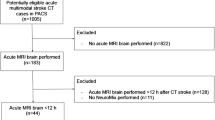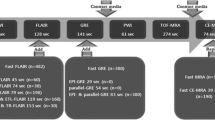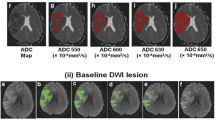Abstract
“Fogging” is the temporary loss of visibility of an infarct on CT which occurs in the subacute phase at about 2 weeks after stroke. It occurs in up to 40% of medium to large infarcts on CT. It is unclear whether or how often fogging occurs on T2-weighted MR, but if it does occur, it can cause underestimation of true infarct size. This study examined the possible frequency and time scale of “fogging” on T2-weighted MR. We conducted a blinded, independent review of prospectively collected MR scans from patients with symptoms of cortical ischaemic stroke, scanned sequentially up to 7 weeks after stroke. On each scan maximum infarct area was measured, and the infarct extent and swelling were coded on a validated scale. “Fogging” was suggested by reduced infarct extent between initial and subsequent scans. In 30 patients (with 74 scans) there was some apparent “fogging” in 50% of patients between 6 and 36 days (median 10 days) after stroke. Reduction in infarct extent on T2-weighted MR which may be attributed to “fogging” occurs in a significant proportion of patients with cortical infarcts. This may lead to an underestimation of true final infarct extent. This suggests that true infarct extent on T2-weighted MR can probably only be assessed on scans obtained beyond 7 weeks after stroke.





Similar content being viewed by others
References
Skriver EB, Olsen TS (1981) Transient disappearance of cerebral infarcts on CT scan, the so-called fogging effect. Neuroradiology 22:61–65
Becker H, Desch H, Hacker H, Pencz A (1979) CT Fogging effect with ischaemic cerebral infarcts. Neuroradiology 18:185–192
Wardlaw JM (2001) Is it an infarct or a haemorrhage? In: Warlow CP, Dennis MS, Hankey G, Sandercock PAG, Van Gijn J, Bamford J, Wardlaw JM (eds) Stroke: a practical guide to management, 2nd edn. Blackwell, Oxford
Mullins ME, Schaefer PW, Sorensen AG, Halpern EF, Ay H, He J, Koroshetz WJ, Gonzalez RG (2002) CT and conventional and diffusion weighted MR imaging in acute stroke: study in 691 patients at presentation to the Emergency Department. Radiology 224:353–360
Fisher M, Sotak C (1992) Diffusion weighted MR imaging and ischaemic stroke. AJNR Am J Neuroradiol 13:1103–1105
Yamada K, Wu O, Gonzalez G, Bakker D, Ostergaard L, Copen WA, Weisskoff RM, Rosen BR, Yagi K, Nishimura T, Sorensen AG (2002) Magnetic resonance perfusion-weighted imaging of acute cerebral infarction. Effect of the calculation methods and underlying vasculopathy. Stroke 33:87–94
Feihler J, Foth M, Kucinski T, Knab R, von Bezold M, Wuller C, Zeumer H, Rother T (2002) Severe ADC decreases do not predict irreversible tissue damage in humans. Stroke 33:79–86
Kidwell CS, Alger JR, Saver JL, Mattiello JH, Woods RP, Starkman S, Liebeskind DS, Vespa PM, Jahan R, Gobin YP, Sayre J, Duckwiler GR (2000) MR signatures of infarction versus salvageable penumbra in acute human stroke. Stroke 31:285
Uchino A, Miyoshi T, Ohno M (1999) Fogging effect and MR imaging. Radiat Med Imaging Radiat Oncol 3:99–102
Scuotto A, Cappabianca S, Melone MB, Puoti G (1997) MRI Fogging in cerebellar ischaemia: case Report. Neuroradiology 39:785–787
Pereira AC, Doyle VL, Clifton A, Howe FA, Griffiths JR, Brown MM (2000) The transient disappearance of cerebral infarction on T2 W MRI. Clin Radiol 55:725–727
Asato R, Okumura R, Miki Y, Konishi J (1994) MR T2 W image of subacute cerebral infarct can be isointense to the surrounding brain: MR fogging in cerebral infarct. Magn Reson Mater Phys Biol Med 2:539–544
Wardlaw JM, Marshall I, Wild J, Dennis MS, Cannon J, Lewis SC (1998) Studies of acute ischaemic stroke with proton magnetic resonance spectroscopy. Relation between time from onset, neurological deficit, metabolite abnormalities in the infarct, blood flow, and clinical outcome. Stroke 29:1618–1624
Bastin ME, Rana AK, Wardlaw JM, Armitage PA, Keir SL (2000) A study of the apparent diffusion coefficient of grey and white matter in human ischaemic stroke. Neuroreport 11:2867–2874
Bamford J, Sandercock P, Dennis M, Burn J, Warlow C (1991) Classification and natural history of clinically identifiable subtypes of cerebral infarction. Lancet 337:1521–1526
Wardlaw JM, Sellar R (1994) A simple practical classification of cerebral infarcts on CT and its interobserver reliability AJNR Am J Neuroradiol 15:1933–1939
Jager R, Soh C, Beric V, Losseff N, Brown MM (2003) Haemorrhagic transformation of acute ischaemic infarcts: a pitfall in the interpretation of DWI images and ADC maps. Presented at the Annual Meeting of the British Society of Neuroradiologists, October 2002, Winchester. Neuroradiology 45:119
Acknowledgements
The original MR study was funded by the UK Medical Research Council Clinical Research Initiative in Clinical Neurosciences Grant reference G9301975. We are grateful to Dr. S. Gretton for assistance in the study.
Author information
Authors and Affiliations
Corresponding author
Rights and permissions
About this article
Cite this article
O’Brien, P., Sellar, R.J. & Wardlaw, J.M. Fogging on T2-weighted MR after acute ischaemic stroke: how often might this occur and what are the implications?. Neuroradiology 46, 635–641 (2004). https://doi.org/10.1007/s00234-004-1230-2
Received:
Accepted:
Published:
Issue Date:
DOI: https://doi.org/10.1007/s00234-004-1230-2




